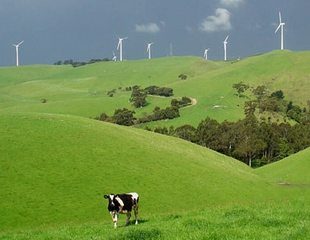In 2007 I took a job working as a policy adviser in then Premier John Brumby’s Office of Climate Change. At the time, it felt like one of the best jobs in the world. While John Howard refused to sign the Kyoto Protocol and had no credible domestic climate change policy, the states stepped up to fill the climate policy vacuum. It was a pleasure to be a part of it.
Victoria teamed up with other states to set the foundations for an emissions trading scheme, and introduced a Victorian Renewable Energy Target. Once Kevin Rudd was elected he promised to increase the Federal RET and introduce federal emissions trading scheme. Therefore, most state schemes were rolled back or rolled into the national policies.

This was the right thing to do. Climate change policy is generally more efficient at a national level, but we now find ourselves back in the same position as 2007: with a federal government who doesn’t believe we should do anything about climate change, and has tried their hardest to roll back every climate change policy they could.
The long battle to save the federal Renewable Energy Target successfully salvaged the policy overall; but was unsuccessful in that the target was slashed by approximately 20 per cent.
It also now looks like it will include burning native forests as “renewable energy”.
What was once a powerful tool for stimulating investment in renewable energy and jobs is now significantly weakened, and this will have huge impacts on our industry, economy and climate.
The good news is, with a new Victorian government, states can again step in to fill the void.
Although the Andrews government refused to commit to a Victorian Renewable Energy Target during the election campaign, despite calls from the Greens and groups like Friends of the Earth and Yes2Renewables, I’m delighted they have now announced their intention to introduce one. But there’s a worrying catch.
Provision 7C in the federal RET legislation that says a state scheme that’s substantially similar to the Federal scheme is invalidated. This means the Victorian government is relying on Tony Abbott to change the law so they’re allowed to introduce a VRET.
I’m glad the Victorian government is pressuring Abbott to get out of the way. We should call out his inaction on renewables at every turn. However, if Abbott refuses, there is another way, and it’s one I hope the Victorian government will embrace.
Section 7C only restricts schemes which are similar to the federal RET, which by no means eliminates all options. Victoria’s existing dormant VRET legislation is too similar to operate concurrently with Section 7C of the federal scheme. But the government could very easily make new laws that approach the question from a different angle, just as the ACT has done.
Other jurisdictions, including the ACT and the UK, encourage renewables through policies that are sufficiently different to the Federal RET. If Victoria did the same, we could create renewable energy on top of the weakened RET.
By using feed-in tariffs and contracts-for-difference policies rather than renewable energy certificates (as the RET does) we can not only bypass Abbott, but grow our renewables and manufacturing industries, reduce the wholesale price of energy, and reduce carbon emissions.
(For a good overview of the exact policy solutions we could adopt, see this great Conversation article here).
The ACT’s scheme is on track to achieve its target of 90 per cent renewable energy by 2020. This policy supported the creation the Ararat Wind Farm here in Victoria, which begs the question: why isn’t the Victorian government supporting projects like this in our own backyard?
Calling for a VRET that depends on a change to Commonwealth legislation – unlikely to be forthcoming from the federal Coalition – is an easy way for Victorian Labor to take potshots at Abbott, but it might not be the best way to get the policy outcome we need.
Although Abbott deserves to be criticised for his attempts to wreak wanton destruction on renewable energy in Australia, we can’t let Labor hide behind a bad Abbott policy.
The cynic might say that Victorian Labor isn’t serious about the policy, and instead wants to highlight Abbott’s failures while not having to actually introduce any policies. But I’m more optimistic than that. Victoria has both the opportunity and the responsibility to take real action, and I want to work with the Labor government to achieve this.
The first step is to pressure Abbott to remove 7C, and the Greens will work with the cross-bench in federal Parliament to do just that. If Labor is serious about renewables policy, Bill Shorten must also join this push.
But if that fails, Victoria must go around Abbott.
This is why yesterday the Greens moved in Victorian Parliament to send options for a VRET to a Parliamentary Inquiry, so we can discuss other possibilities. We know it is possible in practice – all we need now is the leadership from the Andrews government to make it happen.
Ellen Sandell MP is State Member for Melbourne










